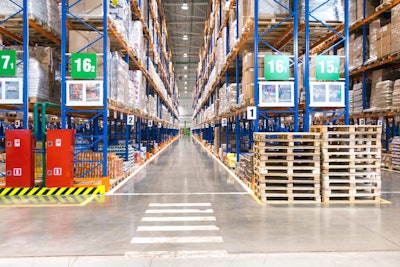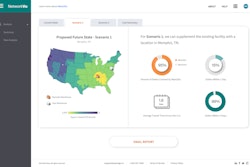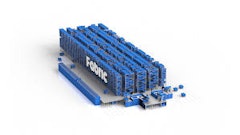
The Coronavirus disease (COVID-19) has led to an undeniable e-commerce boom. While this is good news for distribution centers and warehouses, dramatic increases in the volume of inbound cardboard and pallets have brought on new challenges. High volumes of corrugated cardboard (OCC) and pallets can create safety issues and hinder operational efficiency. Given the e-commerce boom shows no signs of stopping, now is the time to consider corrugate and pallet management services to maximize your warehouse operations, efficiency and safety.
Management best practices
Running a distribution center or warehouse involves having your finger on the pulse of dozens of operations. From tracking inventory to streamlining shipping processes, it can be a challenge to keep track of all the moving parts. When it comes to OCC and pallets in the warehouse, poor management can throw a wrench in an already convoluted process. Cardboard and pallet management is one of the most forgotten about components of running a functional distribution center. Without a solid management plan, OCC and pallets can occupy valuable space, pose safety risks, and waste employee shift time. When considering a management service provider, it’s important to select a company that can help to seamlessly incorporate a cardboard and pallet management strategy into your operational plan. Considerations like determining the right method for gathering corrugate at point of generation and transporting to point of disposal inside the warehouse can play a key part in the success of your facility’s management strategy.
It is also important to consider the material in which your warehouse pallets are composed of. While both plastic and wood pallets have advantages and disadvantages, there is a clear favorite amongst distribution centers and warehouses. Wood pallets, while cheaper and biodegradable, have an average lifespan of 5-8 trips before they start to break down. Due to the porous nature of wood, the material is also at higher risk of contamination and is not suited for pharmaceuticals or chemicals. Plastic pallets in comparison, are lighter, easier to clean and can last around 250 trips before they are recycled. From arrival to disposal, selecting a pallet material that works best for your facility’s needs is essential.
Employee health and safety
With roughly 2 billion pallets circulating in the United States, it serves warehouse managers to employ pallet management services. High cardboard and pallet volumes obstruct daily ability to fulfill orders, maximize uptime, and streamline business continuity. With so many moving parts in warehouse operations, obstructions in your building and poor OCC and pallet management can create safety hazards for manpower and equipment. Mishandled pallets used in supply chain operations can lead to injuries such as puncture wounds, sprained ankles, strained muscles or worse. Pallet management services can help prevent warehouse injury by safely handling debris, restricting the height of stacked pallets and more.
Essential warehouse tools like double-pallet jacks can help simplify the internal transport of pallets and corrugate by allowing warehouse workers to move thousands of pounds of inventory within minutes. However, it is important for training to take place prior to jack usage to avoid injury. Safety and efficiency considerations like having your teamwork in bulk to minimize equipment usage, posting a list of inspection and handling requirements around the warehouse and scheduling preventative equipment maintenance can help avoid operational issues and safety risks.
Financial benefit and increased efficiency
Increasing workforce productivity ranks is one of the top issues faced by the average warehouse. Disorganized processes can lead to costly mistakes, delays and product losses. Employing a corrugate and pallet management services provider means increased employee efficiency overall. With over 90% of products shipped with cardboard, it’s no wonder warehouses can easily get overwhelmed with a surplus of OCC. Without the worry of materials piling up, your workers’ time is better spent in other areas of warehouse operations.
Because of high demand for packaging, recycling clean and dry OCC in a compactor or baler can generate revenue for your facility. If your business is collecting volumes of 5 tons of OCC per month or more, rebates may be available to you. Selecting a service provider that can help navigate fluctuating OCC market prices means one more aspect of your business operations that you don’t have to worry about. In addition, employing management services to remove OCC from the distribution center floor and prep it for the next step can help to streamline the disposal and recycling process.
Operational sustainability
According to IBM’s 2020 U.S. Retail Index, COVID-19 has accelerated the shift from physical stores to e-commerce by five years. As e-commerce numbers continue to rise, so do recycling opportunities. OCC is the No. 1 most recycled packaging material, with more than 50% of recycled OCC used to make more corrugated boxes in 2018. The average corrugated box contains fibers that can be recycled up to 25 times, creating a prime opportunity for sustainability while perpetuating a continuous market for the recovered material. When it comes to pallets, it’s important to communicate a plan with your facility services provider to identify when pallets can be reused and recycled.
Sustainable business operations are becoming a driving factor in consumer decisions. According to a study conducted by the Yale Program on Climate Change Communication, 31% of American consumers say they have rewarded companies that are taking steps to reduce global warming by purchasing their products in the last year. As more OCC is recovered, less goes to landfills, resulting in lower methane emissions. In fact, the recycling of one ton of cardboard saves more than nine cubic yards of landfill space. With the right warehouse management service, implementing sustainable practices will not only benefit your business, but your facility’s environmental footprint in the long term.
Click here to hear more about reuse in warehousing for sustainability:
Going forward
Cardboard and pallet management is often an afterthought when it comes to warehouse manager priorities. However, it is clear that as online sales continue to grow, OCC and pallet management will become even more of a challenge than they are today. Take control of your distribution center operations and prepare for the rising volume of OCC and pallets will decrease your risk and ensure your operations run smoother overall.

















